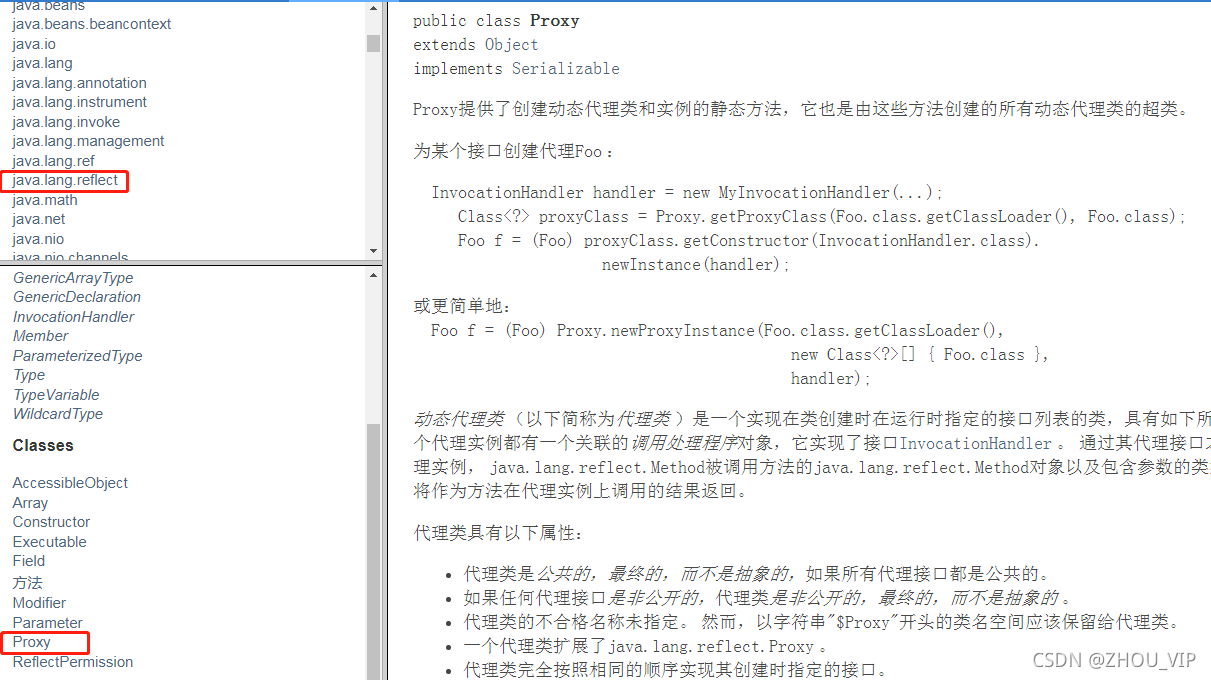

面试经常会问动态代理,
关于动态代理这块有时间要反复地研究,因为它是aop的原理,面试问的概率非常大



文档地址:Java 8 中文版 - 在线API中文手册 - 码工具


扫描二维码关注公众号,回复:
13316805 查看本文章



2 、编写JDK动态代理代码
(1)创建接口,定义方法
(2)创建接口实现类,实现方法
(3)使用Proxy 类创建接口代理对象
package com.company.zs.test;
public interface UserDao {
public int add( int a, int b);
public String update(String id);
}
package com.company.zs.test;
import org.springframework.beans.factory.config.BeanPostProcessor;
public class UserDaoImpl implements UserDao {
@Override
public int add(int a, int b) {
return a+b;
}
@Override
public String update(String id) {
return id;
}
}
package com.company.zs.test;
import java.lang.reflect.InvocationHandler;
import java.lang.reflect.Method;
import java.lang.reflect.Proxy;
import java.util.Arrays;
public class JDKProxy {
public static void main(String[] args) {
//创建接口实现类代理对象
Class[] interfaces = {UserDao. class};
//方法1,可以用匿名类
/*Proxy.newProxyInstance(JDKProxy.class.getClassLoader(), interfaces,
new InvocationHandler() {
@Override
public Object invoke(Object proxy, Method method, Object[] args) throws Throwable {
return null;
}
});*/
//方法2
UserDaoImpl userDao = new UserDaoImpl();
UserDao dao = (UserDao)Proxy. newProxyInstance (JDKProxy. class.getClassLoader(), interfaces, new UserDaoProxy(userDao));
int result = dao.add(1, 2);
System. out .println( "result:"+result);
}
}
//创建代理对象代码
class UserDaoProxy implements InvocationHandler {
//1 把创建的是谁的代理对象,把谁传递过来
//有参数构造传递
private Object obj;
public UserDaoProxy(Object obj) {
this. obj = obj;
}
//增强的逻辑
@Override
public Object invoke(Object proxy, Method method, Object[] args) throws Throwable {
//方法之前
System.out.println("方法之前执行 ...."+method.getName()+ " : 传递的参数 ..."+ Arrays.toString (args));
//被增强的方法执行
Object res = method.invoke( obj, args);
//方法之后
System.out.println("方法之后执行 ...."+ obj);
return res;
}
}
方法之前执行 ....add : 传递的参数 ...[1, 2]
方法之后执行 ....com.company.zs.test.UserDaoImpl@2f92e0f4
result:3




实际开发一般使用注解的方式,非常方便

![]()
一般切入点表达式execution(* ),写*方便,返回类型可以不写,参数列表(..)代表参数
AOP 操作(AspectJ注解方式)
1 、创建类,在类里面定义方法
package com.company.zs.aop;
public class User {
public void add() {
System. out .println( "add.......");
}
}2 、创建增强类(编写增强逻辑)
(1)在增强类里面,创建方法,让不同方法代表不同通知类型
package com.company.zs.aop;
//增强类
public class UserProxy {
public void before() { //前置通知
System. out .println( "before......");
}
}
3 、进行通知的配置
(1)在 spring 配置文件中,开启注解扫描
<?xml version="1.0" encoding="UTF-8"?>
<beans xmlns="http://www.springframework.org/schema/beans"
xmlns:xsi="http://www.w3.org/2001/XMLSchema-instance"
xmlns:context="http://www.springframework.org/schema/context"
xmlns:aop="http://www.springframework.org/schema/aop"
xsi:schemaLocation="http://www.springframework.org/schema/beans http://www.springframework.org/schema/beans/spring-beans.xsd
http://www.springframework.org/schema/context http://www.springframework.org/schema/context/spring-context.xsd
http://www.springframework.org/schema/aop http://www.springframework.org/schema/aop/spring-aop.xsd">
<!-- 开启注解扫描 -->
<context:component-scan base-package="com.company.zs.aop"></context:component-scan>
</beans>(2)使用注解创建User和UserProxy对象


(3)在增强类上面添加注解@Aspect

(4)在spring 配置文件中开启生成代理对象
<?xml version="1.0" encoding="UTF-8"?>
<beans xmlns="http://www.springframework.org/schema/beans"
xmlns:xsi="http://www.w3.org/2001/XMLSchema-instance"
xmlns:context="http://www.springframework.org/schema/context"
xmlns:aop="http://www.springframework.org/schema/aop"
xsi:schemaLocation="http://www.springframework.org/schema/beans http://www.springframework.org/schema/beans/spring-beans.xsd
http://www.springframework.org/schema/context http://www.springframework.org/schema/context/spring-context.xsd
http://www.springframework.org/schema/aop http://www.springframework.org/schema/aop/spring-aop.xsd">
<!-- 开启注解扫描 -->
<context:component-scan base-package="com.company.zs.aop"></context:component-scan>
<!-- 开启Aspect生成代理对象-->
<aop:aspectj-autoproxy></aop:aspectj-autoproxy>
</beans>
4 、配置不同类型的通知
(1)在增强类的里面,在作为通知方法上面添加通知类型注解,使用切入点表达式配置

package com.company.zs.aop;
import org.aspectj.lang.annotation.Aspect;
import org.aspectj.lang.annotation.Before;
import org.springframework.stereotype.Component;
@Component
@Aspect//生成代理对象
public class UserProxy {
@Before(value = "execution(* com.company.zs.aop.User.add(..))")
public void before() { //前置通知
System. out .println( "before......");
}
}
测试:

有五种通知类型,下面全部演示一下:
package com.company.zs.aop;
import org.aspectj.lang.ProceedingJoinPoint;
import org.aspectj.lang.annotation.*;
import org.springframework.stereotype.Component;
@Component
@Aspect//生成代理对象
public class UserProxy {
//前置通知
//@Before 注解表示作为前置通知
@Before(value = "execution(* com.company.zs.aop.User.add(..))")
public void before() { //前置通知
System. out .println( "before......");
}
//后置通知(返回通知)
@AfterReturning(value = "execution(* com.company.zs.aop.User.add(..))")
public void afterReturning() {
System.out.println("afterReturning.........");
}
//最终通知
@After(value = "execution(* com.company.zs.aop.User.add(..))")
public void after() {
System.out.println("after.........");
}
//异常通知
@AfterThrowing(value = "execution(* com.company.zs.aop.User.add(..))")
public void afterThrowing() {
System.out.println("afterThrowing.........");
}
//环绕通知
@Around(value = "execution(* com.company.zs.aop.User.add(..))")
public void around(ProceedingJoinPoint proceedingJoinPoint) throws Throwable {
System.out.println("环绕之前.........");
//被增强的方法执行
proceedingJoinPoint.proceed();
System.out.println("环绕之后.........");
}
}

细节问题:
5、 相同的切入点抽取

6 、有多个增强类多同一个方法进行增强,设置增强类优先级
(1)在增强类上面添加注解 @Order(数字类型值),数字类型值越小优先级越高

再进一步优化,替代配置文件


测试:
@Test
public void testAopanno(){
ApplicationContext context = new AnnotationConfigApplicationContext(ConfigAop.class);
User user = context.getBean("user",User.class);
user.add();
}
AOP操作(AspectJ 配置文件方式,这种方式不常用,了解即可)
1 、创建两个类,增强类和被增强类,创建方法


2 、在spring配置文件中创建两个类对象

3 、在spring配置文件中配置切入点

测试:
